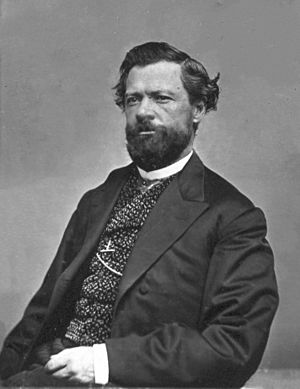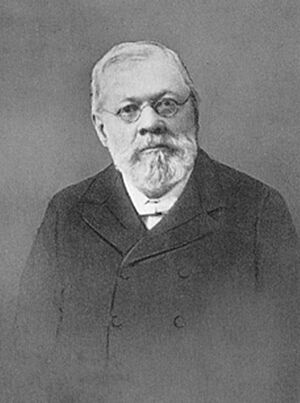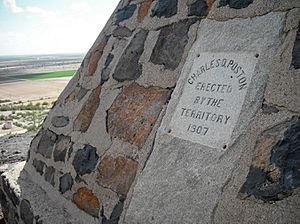Charles Debrille Poston facts for kids
Quick facts for kids
Charles D. Poston
|
|
|---|---|
 |
|
| Delegate to the U.S. House of Representatives from Arizona Territory | |
| In office December 5, 1864 – March 3, 1865 |
|
| Preceded by | None (new territory) |
| Succeeded by | John Noble Goodwin |
| Personal details | |
| Born | April 20, 1825 Elizabethtown, Kentucky, US |
| Died | June 24, 1902 (aged 77) Phoenix, Arizona Territory |
| Political party | Republican |
| Spouses | Margaret Haycraft (1848–1884) Martha Tucker (married 1885) |
Charles Debrille Poston (April 20, 1825 – June 24, 1902) was an American explorer, prospector, author, and politician. He is often called the "Father of Arizona." This is because he worked hard to create the Arizona Territory. Poston also became Arizona Territory's first representative in the U.S. House of Representatives.
Contents
Discovering Charles Poston's Early Life
Charles Poston was born in Elizabethtown, Kentucky. His parents were Temple and Judith Debrille Poston. His father was a printer, and Charles learned the trade. When he was twelve, he became an orphan. He then trained with the local county clerk, Samuel Haycraft.
After his training, he moved to Nashville, Tennessee. There, he worked for the Tennessee Supreme Court. He also studied law. In 1849, Poston married Margaret Haycraft, Samuel's daughter. They had a daughter named Sarah Lee Poston. Margaret became ill in 1851 and was cared for by family. She passed away in 1884. In 1885, Poston married Martha "Mattie" Tucker. They separated shortly after.
Exploring and Mining in the West
Poston traveled to California during the California Gold Rush. In 1851, he got a job at the San Francisco Customs House. While working there, he met French bankers. They were interested in land from the new Gadsden Purchase. In late 1853, Poston joined mining engineer Herman Ehrenberg. They planned an expedition into the new territory.
They sailed from San Francisco but were shipwrecked near Guaymas, Mexico. Mexican officials briefly held them. They then headed north into the Gadsden territory. The expedition visited places like San Xavier del Bac and Ajo. They collected many mineral samples. Along the way, Poston met Major Samuel P. Heintzelman at Fort Yuma. Poston later sold a townsite he surveyed near the fort for $20,000.
After returning to San Francisco, Poston went to the East Coast. He wanted to find money for a mining operation. Major Heintzelman introduced him to investors in Cincinnati, Ohio. On March 24, 1856, they secured $2 million. This money started the Sonora Exploring and Mining Company. Heintzelman became president, and Poston was the managing supervisor.
The company set up its main office in Tubac, Arizona. They began mining in the nearby Santa Rita Mountains. Poston became known as "Colonel" Poston. He acted as the local leader, or alcalde, in Tubac. He even printed his own money. He also performed marriages, divorces, and baptisms. This continued until a church official, Father Macheboeuf, arrived. He questioned the marriages Poston performed. After a donation, the unions were made official. Poston's brother, John, was sadly killed by outlaws in Cerro Colorado, Arizona. This town was also founded by Charles Poston.
Mining operations were very successful, producing a lot of silver daily. However, in 1861, Union troops left the area. This was due to the American Civil War. Without protection, attacks from local Apaches increased. The settlement of Tubac had to be abandoned.
Creating the Arizona Territory
After leaving Tubac, Poston went to Washington, D.C.. He worked for General Heintzelman. During this time, he met President Abraham Lincoln. Poston used this opportunity to talk to Lincoln and Congress. He pushed for the creation of an Arizona Territory. He explained how the area's mineral wealth could help the Union cause.
Poston had Tiffany & Co. create a special inkwell from Arizona silver. He gave this inkwell to President Lincoln. This was when Lincoln signed the Arizona Organic Act. This act officially created the Arizona Territory. On March 12, 1863, Poston was appointed superintendent of Indian affairs. Later, on July 18, 1864, he was elected as the first Delegate to the U.S. House of Representatives for Arizona.
During his time in Congress, Poston worked on bills. These bills aimed to settle land claims. They also sought to create Indian reservations along the Colorado River. In 1865, Poston did not return to Arizona for his reelection campaign. He lost to John Noble Goodwin. He tried again in 1866 but was unsuccessful.
Writing and World Travels
After leaving Congress, Poston opened a law office in Washington D.C. In 1867, he traveled to Europe. He spent time in London and Paris. He then returned to Washington. In 1868, he published a travel book called Europe in the Summer-Time.
Later, U.S. Secretary of State William H. Seward asked Poston for a special task. Poston was to deliver the Burlingame Treaty to the Emperor of China. He was also to study irrigation and immigration in Asia. After China, Poston went to India. There, he became very interested in the Parsi people and their religion, Zoroastrianism. He continued his travels, reaching Egypt and then returning to Paris.
He lived in Paris for a year. Then, he moved to London for six years. In London, he worked as an editor for a newspaper. He was also a foreign correspondent for the New York Tribune. During this time, he wrote several books. These included The Parsees (1872), The Sun Worshippers of Asia (1877), and his poem Apache Land (1878). His work, Building a State in Apache Land, was published in parts between 1894.
Later Years and Legacy
Poston returned to the United States for the Centennial Exposition in Philadelphia. He worked on a political campaign in 1876. He hoped for a consul position in London. Instead, he became the Registrar of the U.S. land office in Florence, Arizona. This was from 1877 to 1879.
In Florence, he became very interested in building a Parsi fire temple. He wanted to build it on a nearby hill. He paid for a road to the top. The temple was decorated with a blue and white flag. It showed a red sun. It was built on the remains of an older structure. Construction stopped when Poston ran out of money. He tried to raise more funds, even writing to the Shah of Iran. But his efforts failed. This unusual interest led some to see Poston as a bit unusual.
After Florence, he moved to Tucson. He worked as a lecturer, mining promoter, and writer. He also held various government jobs. These included a consular agent in Nogales and an employee of the U.S. Geological Survey.
Poston became less well-known over time. However, in 1897, an account of his situation was published. As a result, the Arizona Territorial legislature gave Poston a small monthly pension. This helped him in his later years.
Charles Poston passed away on June 24, 1902, in Phoenix, Arizona Territory. He had wished to be buried on Primrose Hill. However, he was first buried in a simple grave in Phoenix. On the 100th anniversary of his birth, his remains were moved. He was reburied on Primrose Hill, which was renamed Poston Butte. This was the same hill where he had tried to build his "Temple to the Sun." He was laid to rest in an official ceremony.
See also
- List of United States representatives from Arizona
- Hole-in-the-Rock (Papago Park)




